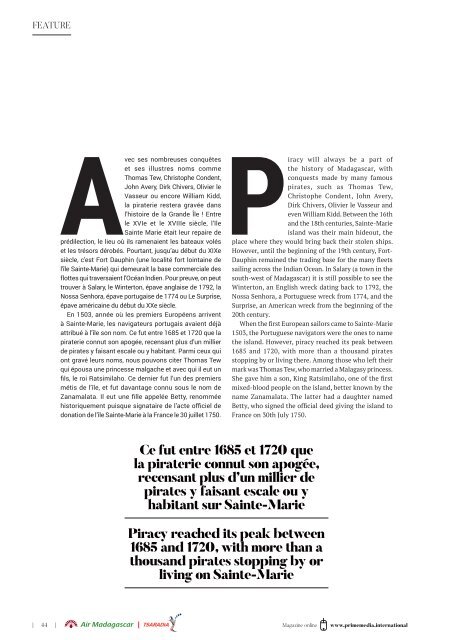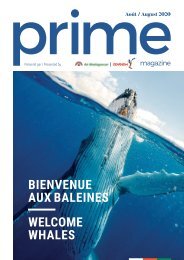Prime Magazine January 2020
Create successful ePaper yourself
Turn your PDF publications into a flip-book with our unique Google optimized e-Paper software.
FEATURE<br />
Avec ses nombreuses conquêtes<br />
et ses illustres noms comme<br />
Thomas Tew, Christophe Condent,<br />
John Avery, Dirk Chivers, Olivier le<br />
Vasseur ou encore William Kidd,<br />
la piraterie restera gravée dans<br />
l’histoire de la Grande Île ! Entre<br />
le XVIe et le XVIIIe siècle, l’île<br />
Sainte Marie était leur repaire de<br />
prédilection, le lieu où ils ramenaient les bateaux volés<br />
et les trésors dérobés. Pourtant, jusqu’au début du XIXe<br />
siècle, c'est Fort Dauphin (une localité fort lointaine de<br />
l'île Sainte-Marie) qui demeurait la base commerciale des<br />
flottes qui traversaient l’Océan Indien. Pour preuve, on peut<br />
trouver à Salary, le Winterton, épave anglaise de 1792, la<br />
Nossa Senhora, épave portugaise de 1774 ou Le Surprise,<br />
épave américaine du début du XXe siècle.<br />
En 1503, année où les premiers Européens arrivent<br />
à Sainte-Marie, les navigateurs portugais avaient déjà<br />
attribué à l’île son nom. Ce fut entre 1685 et 1720 que la<br />
piraterie connut son apogée, recensant plus d’un millier<br />
de pirates y faisant escale ou y habitant. Parmi ceux qui<br />
ont gravé leurs noms, nous pouvons citer Thomas Tew<br />
qui épousa une princesse malgache et avec qui il eut un<br />
fils, le roi Ratsimilaho. Ce dernier fut l’un des premiers<br />
métis de l’île, et fut davantage connu sous le nom de<br />
Zanamalata. Il eut une fille appelée Betty, renommée<br />
historiquement puisque signataire de l’acte officiel de<br />
donation de l’île Sainte-Marie à la France le 30 juillet 1750.<br />
Piracy will always be a part of<br />
the history of Madagascar, with<br />
conquests made by many famous<br />
pirates, such as Thomas Tew,<br />
Christophe Condent, John Avery,<br />
Dirk Chivers, Olivier le Vasseur and<br />
even William Kidd. Between the 16th<br />
and the 18th centuries, Sainte-Marie<br />
island was their main hideout, the<br />
place where they would bring back their stolen ships.<br />
However, until the beginning of the 19th century, Fort-<br />
Dauphin remained the trading base for the many fleets<br />
sailing across the Indian Ocean. In Salary (a town in the<br />
south-west of Madagascar) it is still possible to see the<br />
Winterton, an English wreck dating back to 1792, the<br />
Nossa Senhora, a Portuguese wreck from 1774, and the<br />
Surprise, an American wreck from the beginning of the<br />
20th century.<br />
When the first European sailors came to Sainte-Marie<br />
1503, the Portuguese navigators were the ones to name<br />
the island. However, piracy reached its peak between<br />
1685 and 1720, with more than a thousand pirates<br />
stopping by or living there. Among those who left their<br />
mark was Thomas Tew, who married a Malagasy princess.<br />
She gave him a son, King Ratsimilaho, one of the first<br />
mixed-blood people on the island, better known by the<br />
name Zanamalata. The latter had a daughter named<br />
Betty, who signed the official deed giving the island to<br />
France on 30th July 1750.<br />
Ce fut entre 1685 et 1720 que<br />
la piraterie connut son apogée,<br />
recensant plus d’un millier de<br />
pirates y faisant escale ou y<br />
habitant sur Sainte-Marie<br />
Piracy reached its peak between<br />
1685 and 1720, with more than a<br />
thousand pirates stopping by or<br />
living on Sainte-Marie<br />
| 44 | <strong>Magazine</strong> online www.primemedia.international

















